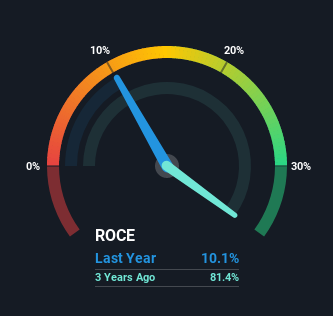- India
- /
- Electrical
- /
- NSEI:SUZLON
Investors Could Be Concerned With Suzlon Energy's (NSE:SUZLON) Returns On Capital

Finding a business that has the potential to grow substantially is not easy, but it is possible if we look at a few key financial metrics. In a perfect world, we'd like to see a company investing more capital into its business and ideally the returns earned from that capital are also increasing. If you see this, it typically means it's a company with a great business model and plenty of profitable reinvestment opportunities. However, after investigating Suzlon Energy (NSE:SUZLON), we don't think it's current trends fit the mold of a multi-bagger.
Return On Capital Employed (ROCE): What is it?
For those who don't know, ROCE is a measure of a company's yearly pre-tax profit (its return), relative to the capital employed in the business. The formula for this calculation on Suzlon Energy is:
Return on Capital Employed = Earnings Before Interest and Tax (EBIT) ÷ (Total Assets - Current Liabilities)
0.10 = ₹2.8b ÷ (₹66b - ₹38b) (Based on the trailing twelve months to March 2021).
Thus, Suzlon Energy has an ROCE of 10%. That's a pretty standard return and it's in line with the industry average of 9.8%.
Check out our latest analysis for Suzlon Energy

Historical performance is a great place to start when researching a stock so above you can see the gauge for Suzlon Energy's ROCE against it's prior returns. If you want to delve into the historical earnings, revenue and cash flow of Suzlon Energy, check out these free graphs here.
The Trend Of ROCE
Unfortunately, the trend isn't great with ROCE falling from 46% five years ago, while capital employed has grown 35%. However, some of the increase in capital employed could be attributed to the recent capital raising that's been completed prior to their latest reporting period, so keep that in mind when looking at the ROCE decrease. It's unlikely that all of the funds raised have been put to work yet, so as a consequence Suzlon Energy might not have received a full period of earnings contribution from it.
On a side note, Suzlon Energy has done well to pay down its current liabilities to 58% of total assets. So we could link some of this to the decrease in ROCE. Effectively this means their suppliers or short-term creditors are funding less of the business, which reduces some elements of risk. Since the business is basically funding more of its operations with it's own money, you could argue this has made the business less efficient at generating ROCE. Either way, they're still at a pretty high level, so we'd like to see them fall further if possible.
The Bottom Line
In summary, despite lower returns in the short term, we're encouraged to see that Suzlon Energy is reinvesting for growth and has higher sales as a result. These growth trends haven't led to growth returns though, since the stock has fallen 61% over the last five years. As a result, we'd recommend researching this stock further to uncover what other fundamentals of the business can show us.
If you want to know some of the risks facing Suzlon Energy we've found 5 warning signs (2 can't be ignored!) that you should be aware of before investing here.
For those who like to invest in solid companies, check out this free list of companies with solid balance sheets and high returns on equity.
If you decide to trade Suzlon Energy, use the lowest-cost* platform that is rated #1 Overall by Barron’s, Interactive Brokers. Trade stocks, options, futures, forex, bonds and funds on 135 markets, all from a single integrated account. Promoted
New: Manage All Your Stock Portfolios in One Place
We've created the ultimate portfolio companion for stock investors, and it's free.
• Connect an unlimited number of Portfolios and see your total in one currency
• Be alerted to new Warning Signs or Risks via email or mobile
• Track the Fair Value of your stocks
This article by Simply Wall St is general in nature. We provide commentary based on historical data and analyst forecasts only using an unbiased methodology and our articles are not intended to be financial advice. It does not constitute a recommendation to buy or sell any stock, and does not take account of your objectives, or your financial situation. We aim to bring you long-term focused analysis driven by fundamental data. Note that our analysis may not factor in the latest price-sensitive company announcements or qualitative material. Simply Wall St has no position in any stocks mentioned.
*Interactive Brokers Rated Lowest Cost Broker by StockBrokers.com Annual Online Review 2020
Have feedback on this article? Concerned about the content? Get in touch with us directly. Alternatively, email editorial-team (at) simplywallst.com.
About NSEI:SUZLON
Suzlon Energy
Manufactures and sells wind turbine generators and related components in India and internationally.
Exceptional growth potential with outstanding track record.


